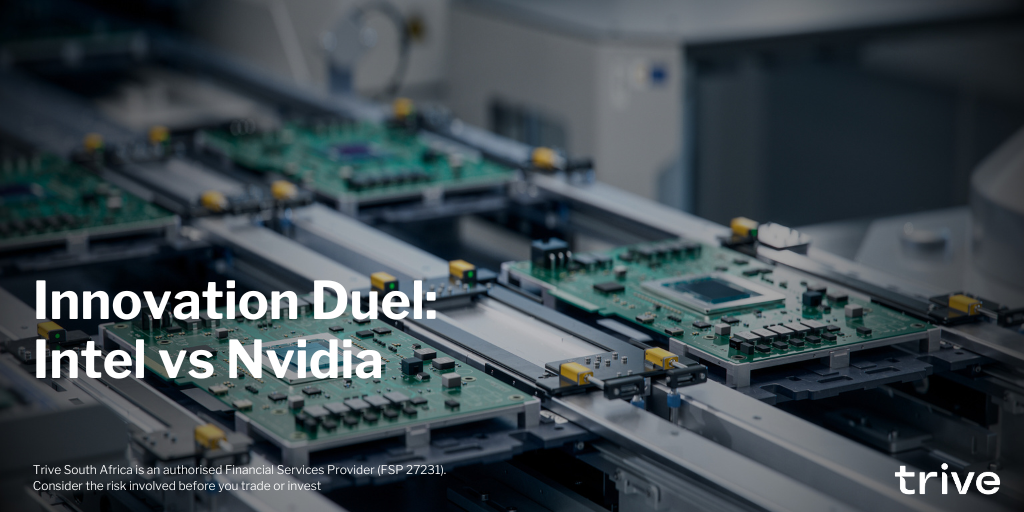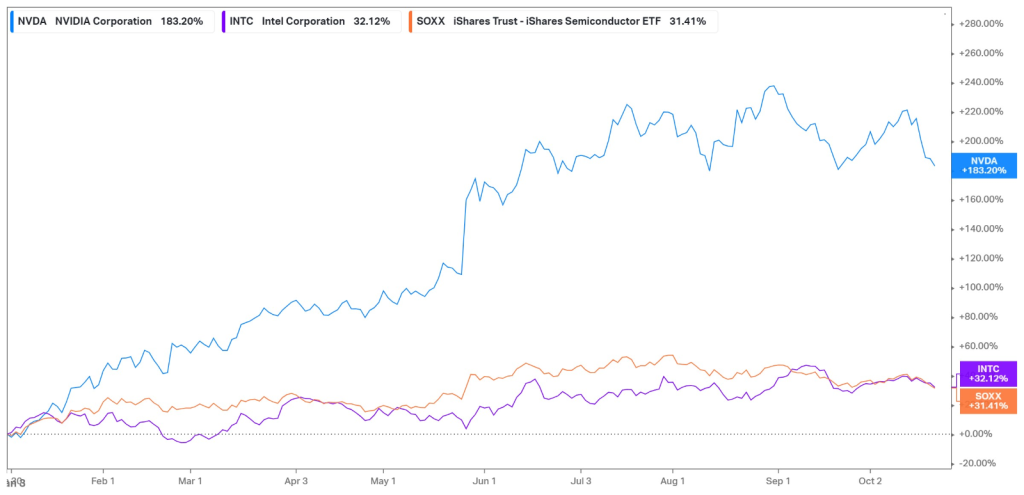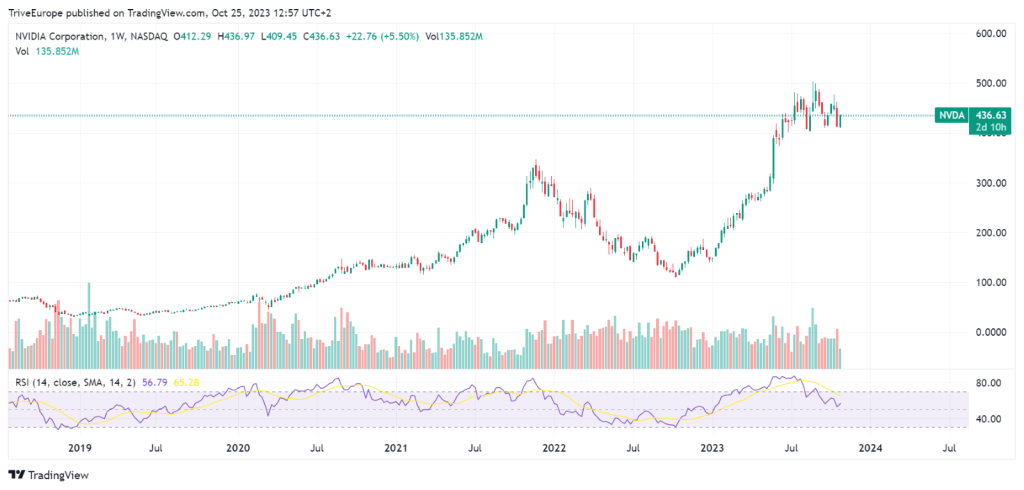
In the past year, the semiconductor industry has been on everyone’s lips, dazzling observers as it effortlessly outshined the broader market. In the graph below, you’ll witness the solid performance of the iShares Semiconductor ETF, guided by the industry’s titans, Intel and Nvidia. Nvidia, the trailblazer in the AI domain, has set the stage on fire with an incredible surge of 183.2%. Their pioneering efforts are steering the ship toward AI’s uncharted waters, and the world is taking note. Now, shifting the spotlight to Intel, who’ve been making their own strides. However, they’ve had their fair share of hurdles, especially with the sluggish PC market putting on the brakes. As they navigate their way in the challenging AI chip market, the question beckons: Can Intel rise to the occasion and close in on Nvidia’s stellar supremacy in the AI universe?

Source: Trive – Koyfin, Tiaan van Aswegen
As we witness Nvidia’s remarkable surge, it brings back a similar sense of optimism around the technological innovation that started the dot com boom. During this time, Intel dominated the market for central processors, or CPUs, which, at the time, was the most important part of the computer. In 1998, Intel’s share price surged by 69%, with another 39% expansion in 1999, as shown in the chart below. However, following the burst of the dot com bubble, the share price declined close to 27%, and the price was never able to recover toward the $75.81 peak in 2000. Now, a shift has occurred in the market, as the development of AI and large language models require a lot more computing power, and this is where Nvidia thrives.

Source: Trive – Tradingview, Tiaan van Aswegen
To increase the pace of AI development, data centre CPUs require powerful graphic processing units (GPUs) with the ability to perform parallel tasks efficiently. The most advanced systems often use numerous GPUs for every CPU. For example, Nvidia’s DGX system, which is basically an AI computer, uses eight of Nvidia’s H-100 GPUs and only two CPUs. Nvidia got ahead of the curve by figuring out that graphics cards could be programmed in a way to execute parallel processing needed for AI and have since cemented their place at the top of the AI food chain due to the high demand for these GPUs. According to Statista, the AI chip market reached €18.91Bn in 2022, with an estimated compound annual growth rate (CAGR) of 30.3% through to 2030, which will take the market size to €156Bn. Visual capitalist estimates that as of August 2023, Nvidia holds over 70% of the market share for AI chips, which has led to a stark increase in its data centre revenue. Data centre revenue includes CPUs, GPUs, and data processing units (DPUs). The graph below shows the shift in the industry, as Intel has historically generated more data centre revenue than Nvidia until recently, when lower demand for CPUs and higher demand for GPUs have quadrupled Nvidia’s data centre revenue over the last two years, while Intel has seen a decline in its top line from this segment.

Source: Trive – Visual Capitalist, Tiaan van Aswegen
So, with this shift in the industry toward GPUs, Nvidia’s share price reacted similarly to what we saw with Intel leading up the dot com bubble in 2000, as seen below. With the share price rising to unprecedented heights, it is now consolidating close to its peak. With competition heating up, Nvidia’s place atop the AI throne depends on whether the AI revolution will be incremental for CPU demand or whether the GPUs will continue to displace CPUs across data centres. However, if history taught us anything, it is to be aware of a potential pullback that could arise if the market overreacted to the optimism around AI. So, as we advance, the question remains: Is the recent AI boom a bubble or a justified reaction toward the value that could be created from the fundamental shift in the technology realm?

Source: Trive – Tradingview, Tiaan van Aswegen
Summary
With the recent developments in AI, there has been a slight separation in the semiconductor industry, with Nvidia and its dominance in the GPU market leading the race, causing competitors like Intel, who rely more on CPUs, to fall behind. As we advance, competition should heat up, with Intel and other semiconductor companies no doubt working on strategies to get their slice of the AI pie. Nvidia’s stellar rise hangs in the balance, with Intel looking to make inroads with its own GPUs to compete for a position atop the AI throne. To add to the excitement of this thrilling race, Intel reports its quarterly earnings on Thursday, the 26th of October, where investors should get additional insights into Intel’s progress of providing cheaper alternatives to run the AI revolution.
Sources: Tradingview, Koyfin, Statista, Visual Capitalist, Nvidia Corporation, Intel Corporation
Piece written by Tiaan van Aswegen, Trive Financial Market Analyst
Disclaimer: Trive South Africa (Pty) Ltd, Registration number 2005/011130/07, and an Authorised Financial Services Provider in terms of the Financial Advisory and Intermediary Services Act 2002 (FSP No. 27231). Any analysis/data/opinion contained herein are for informational purposes only and should not be considered advice or a recommendation to invest in any security. The content herein was created using proprietary strategies based on parameters that may include price, time, economic events, liquidity, risk, and macro and cyclical analysis. Securities involve a degree of risk and are volatile instruments. Market and economic conditions are subject to sudden change, which may have a material impact on the outcome of financial instruments and may not be suitable for all investors. When trading or investing in securities or alternative products, the value of the product can increase or decrease meaning your investment can increase or decrease in value. Past performance is not an indication of future performance. Trive South Africa (Pty) Ltd, and its employees assume no liability for any loss or damage (direct, indirect, consequential, or inconsequential) that may be suffered from using or relying on the information contained herein. Please consider the risks involved before you trade or invest.




